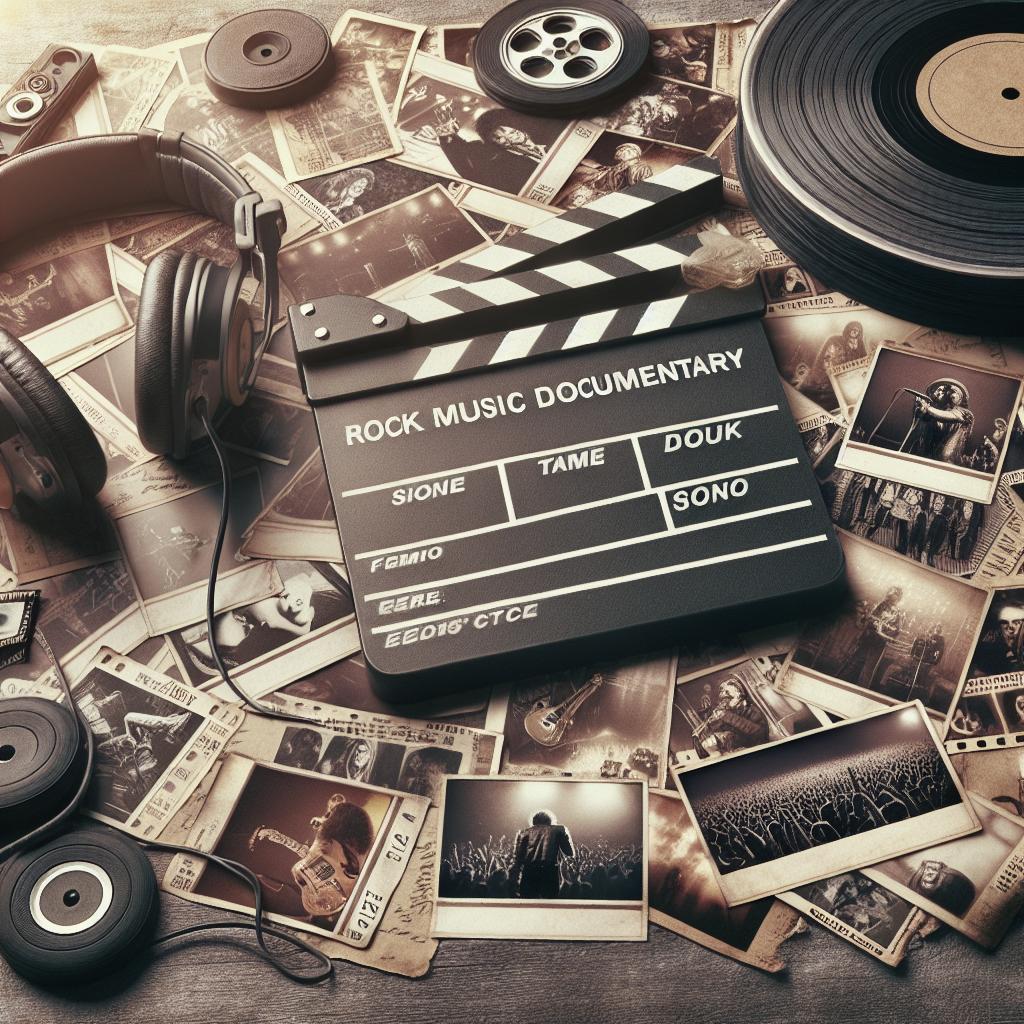Music documentaries offer an intimate lens through which we can experience the highs and lows of our favorite bands, capturing their stories both on and off the stage. This blog post delves into some of the best music documentaries featuring rock bands, from the classic era-defining anthems of rock ‘n’ roll to the raw and edgy punk scenes. Covering a broad spectrum of styles and periods, these films not only document the music but also the cultural impact, the personal struggles, and the societal changes influenced by these artists. Whether you are a hardcore fan, a casual listener, or someone curious about the behind-the-scenes action, this list provides an extensive guide to essential rock music documentaries that have left an indelible mark on the genre.
‘U2: Rattle and Hum’ (1988)
“U2: Rattle and Hum” captures the essence of U2 during their pivotal Joshua Tree Tour. This documentary stands out for its blend of live performances and behind-the-scenes footage, presenting the band at the peak of their career. Directed by Phil Joanou, it gives fans a glimpse of U2’s transition from local heroes to global rock icons. The film isn’t just a concert performance; it dives deep into the band’s exploration of American roots music. From visiting Graceland to collaborating with blues legend B.B. King, “Rattle and Hum” showcases U2’s sonic expansion. The documentary captures the band’s emotional and musical journey, making it a must-watch for any rock enthusiast.
‘It Might Get Loud’ (2008)
Directed by Davis Guggenheim, “It Might Get Loud” features a unique gathering of three legendary guitarists: Jimmy Page of Led Zeppelin, The Edge of U2, and Jack White of The White Stripes. The documentary focuses on the history, influences, and styles of these guitarists, revealing a personal side rarely seen. Each guitarist discusses their inspirations and techniques, offering invaluable insights into their creative processes. The highlight of the documentary is when the three come together for a jam session, blending their distinct styles into an electrifying dialogue. The film stands as a tribute to the art of guitar playing and the impact of these musicians on rock music.
‘American Hardcore’ (2006)
“American Hardcore” delves into the punk rock scene of the late 70s and early 80s, capturing the raw energy and rebellious spirit that defined the genre. Directed by Paul Rachman, it features interviews with members of iconic punk bands like Black Flag, Minor Threat, and Bad Brains. The documentary illustrates the socio-political context in which hardcore punk emerged, providing a gritty and unfiltered view of the scene. By combining rare live footage with candid interviews, “American Hardcore” serves as a crucial chronicle of a movement that reshaped alternative music and youth culture.
‘Heavy Metal Parking Lot’ (1986)
An underground cult classic, “Heavy Metal Parking Lot” is a short documentary by John Heyn and Jeff Krulik that offers a snapshot of youthful exuberance outside a Judas Priest concert in 1986. The film is renowned for its raw and unpolished depiction of metal fans, capturing a unique subculture. It’s a fascinating time capsule of the heavy metal scene, showcasing fans in their natural habitat: the parking lot. With its candid interviews, the documentary provides an authentic look at the attitudes, fashion, and lifestyles of metal heads during the ’80s. “Heavy Metal Parking Lot” remains a beloved documentary for its genuine portrayal of rock fandom.
‘1991: The Year That Punk Broke’ (1992)
Directed by Dave Markey, “1991: The Year That Punk Broke” follows Sonic Youth on their European tour just as the grunge movement was about to explode. Alongside Sonic Youth, the documentary features early performances by Nirvana, highlighting the band just before they achieved mainstream success. The film captures the chaotic and spontaneous energy of the tour, providing a glimpse into the lives of these musicians during a pivotal moment in music history. Fans get to witness raw, unfiltered performances and candid backstage interactions, making it an essential watch for those interested in the early 90s alternative rock scene.
‘End of the Century: The Story of the Ramones’ (2003)
“End of the Century” chronicles the legacy of one of punk rock’s most influential bands, The Ramones. Directed by Jim Fields and Michael Gramaglia, the documentary traces the band’s origins, rise to fame, and the personal struggles that plagued them throughout their career. Featuring interviews with band members and rare archival footage, the film provides a comprehensive account of The Ramones’ impact on rock music. It delves into their turbulent relationships, the pressures of fame, and their enduring influence on subsequent generations of musicians. For any punk rock aficionado, “End of the Century” is a definitive watch.
‘Matangi/Maya/M.I.A.’ (2018)
Directed by Steve Loveridge, “Matangi/Maya/M.I.A.” offers an intimate look into the life of British-Sri Lankan artist M.I.A. The documentary combines home video footage, interviews, and archival clips, showcasing her journey from refugee to international pop sensation. The film explores themes of identity, activism, and the power of music as a tool for social change. By highlighting M.I.A.’s unique blend of hip-hop, electronic, and world music, “Matangi/Maya/M.I.A.” captures the artist’s unyielding spirit and her impact on the global music scene.
‘The Concert for Bangladesh’ (1972)
Hosted by George Harrison and Ravi Shankar, “The Concert for Bangladesh” is one of the first major music benefits. Directed by Saul Swimmer, this documentary captures the concert held at Madison Square Garden in 1971 to raise awareness and funds for refugees affected by the Bangladesh Liberation War. Featuring performances by Bob Dylan, Eric Clapton, Ringo Starr, and others, the film showcases the power of music to unite and effect change. It’s a historic event documented beautifully, illustrating how artists can come together for a greater cause.
‘Rust Never Sleeps’ (1979)
Directed by Neil Young and released as an album and film, “Rust Never Sleeps” chronicles Young’s 1978 tour. The documentary is unique in its surreal presentation, blending concert footage with stage antics involving oversized props and roadies dressed as Jawas from “Star Wars.” The film captures Young’s innovative spirit and the raw energy of his performances. Featuring classics like “Hey Hey, My My” and “Cortez the Killer,” “Rust Never Sleeps” remains a significant work that showcases Neil Young’s enduring influence on rock music.
‘Leonard Cohen: Bird on a Wire’ (1974)
“Leonard Cohen: Bird on a Wire,” directed by Tony Palmer, documents Cohen’s 1972 European tour, offering an unparalleled glimpse into the life of the iconic singer-songwriter. The film captures Cohen both onstage and off, revealing his deeply introspective and often melancholic nature. Featuring intimate performances of songs like “Suzanne” and “So Long, Marianne,” the documentary showcases Cohen’s poetic genius. The raw and unfiltered footage allows fans to see the vulnerability and artistry that defined his career, making it an essential watch for Cohen admirers.
‘Let’s Get Lost’ (1988)
“Let’s Get Lost,” directed by Bruce Weber, is a hauntingly beautiful documentary about jazz trumpeter Chet Baker. The film combines candid interviews, archival footage, and stunning black-and-white photography to chronicle Baker’s tumultuous life and career. The documentary captures Baker’s charm and talent while also delving into his struggles with addiction and personal demons. “Let’s Get Lost” is more than a music documentary; it’s a poignant exploration of fame, artistry, and fallibility, resonating with viewers beyond the realm of jazz.
‘The Punk Singer’ (2013)
Directed by Sini Anderson, “The Punk Singer” centers on Kathleen Hanna, frontwoman of the punk bands Bikini Kill and Le Tigre, and a pioneering figure in the riot grrrl movement. The documentary explores Hanna’s radical influence on punk rock and feminism through interviews, archival footage, and performances. The film delves into Hanna’s activism, highlighting her role in promoting feminist ideals within the punk scene. “The Punk Singer” is not just about Hanna’s music but her lasting impact on gender politics in rock, making it a vital documentary for understanding the intersection of music and activism.
‘A Poem Is a Naked Person’ (1974)
Directed by Les Blank, “A Poem Is a Naked Person” captures the enigmatic life of songwriter Leon Russell during the early 70s. The documentary offers a vivid and often surreal depiction of Russell’s world, blending concert footage, studio sessions, and glimpses of his eccentric lifestyle. The film remained unreleased for decades due to complicated legal issues, adding to its mystique. “A Poem Is a Naked Person” is a testament to Les Blank’s distinctive documentary style, combining music, culture, and art in a way that captivates and entertains.
‘Festival’ (1967)
“Festival,” directed by Murray Lerner, is a pioneering music documentary that captures the Newport Folk Festival from 1963 to 1966. The film features performances by legends like Bob Dylan, Joan Baez, and Johnny Cash, showcasing the diversity and richness of folk music during this transformative period. The documentary is notable for its candid and immersive style, bringing viewers into the heart of the festival experience. “Festival” stands as an important historical document, reflecting the social and cultural changes of the 60s through the lens of music.
‘20 Feet From Stardom’ (2013)
Directed by Morgan Neville, “20 Feet From Stardom” shifts the spotlight to the unsung heroes of music: background singers. The documentary features interviews and performances by artists like Darlene Love, Merry Clayton, and Judith Hill, revealing the stories behind their contributions to iconic songs. The film explores the challenges and triumphs of these talented vocalists, highlighting their impact on the music industry. “20 Feet From Stardom” is a moving tribute to the voices that have shaped rock and roll, often going unrecognized by the general public.
‘History of the Eagles’ (2013)
Directed by Allison Ellwood, “History of the Eagles” is an in-depth look at the rise, fall, and enduring legacy of one of America’s most successful rock bands. The comprehensive documentary features interviews with band members, rare archival footage, and exclusive live performances. The film provides a candid look at the band’s internal dynamics, creative processes, and the conflicts that led to their breakup and reunion. “History of the Eagles” offers an all-encompassing view of the band’s career, making it an invaluable resource for fans and music historians alike.
‘The Carter’ (2009)
“The Carter,” directed by Adam Bhala Lough, is a documentary that chronicles the life and career of rapper Lil Wayne. While not a rock documentary per se, the film captures the rockstar energy and lifestyle of one of hip-hop’s most influential figures. The documentary offers an unfiltered and candid look at Lil Wayne’s artistic process, his dedication to music, and the personal struggles that have shaped his life. “The Carter” provides a unique and compelling portrait of an artist at the height of his career, serving as a fascinating study for fans of any genre.
‘Shine a Light’ (2008)
Directed by Martin Scorsese, “Shine a Light” is a concert film that captures The Rolling Stones during a performance at the Beacon Theatre in New York City. The documentary features guest appearances by artists such as Jack White and Christina Aguilera, adding to the star-studded event. Scorsese’s direction brings an energetic and visceral quality to the film, interspersing concert footage with behind-the-scenes moments and archival clips. “Shine a Light” brilliantly showcases the timeless appeal and enduring talent of The Rolling Stones, making it a must-watch for rock fans.
‘Long Strange Trip’ (2017)
Directed by Amir Bar-Lev, “Long Strange Trip” is a comprehensive documentary on the Grateful Dead. Spanning four hours, the film explores the band’s 30-year history, their improvisational style, and their dedicated fan base known as Deadheads. The documentary combines rare footage, interviews, and concert performances, providing an in-depth look at the band’s unique cultural impact. “Long Strange Trip” captures the essence of the Grateful Dead’s music and the sense of community that surrounds them, making it an essential watch for fans and newcomers alike.
‘Jazz on a Summer’s Day’ (1959)
“Jazz on a Summer’s Day,” directed by Bert Stern and Aram Avakian, captures the 1958 Newport Jazz Festival. Though primarily a jazz film, it features performances by rock and roll pioneers like Chuck Berry, illustrating the genre’s crossover appeal. The documentary is noted for its vibrant cinematography and beautifully captures the mood and atmosphere of the festival. With performances by legends like Louis Armstrong and Mahalia Jackson, “Jazz on a Summer’s Day” remains a captivating celebration of music and culture.
‘Hype!’ (1996)
“Hype!” directed by Doug Pray, documents the explosion of the Seattle grunge scene in the early 90s. Featuring interviews and performances by bands like Nirvana, Pearl Jam, and Soundgarden, the film captures the rise of a movement that reshaped rock music. The documentary explores the media frenzy and commercialism that followed the grunge phenomenon, offering a critical perspective on the music industry. “Hype!” serves as an important chronicle of a defining moment in rock history, resonating with fans of the genre.
‘Meeting People Is Easy’ (1998)
Directed by Grant Gee, “Meeting People Is Easy” follows Radiohead during their tour supporting the release of “OK Computer” in 1997. The documentary captures the band’s struggles with fame, media attention, and the pressures of maintaining artistic integrity. The film’s fragmented and chaotic style reflects the band’s state of mind during this tumultuous period. Featuring live performances, behind-the-scenes footage, and candid interviews, “Meeting People Is Easy” provides a fascinating look at one of the most influential bands of the 90s.
‘Shut Up and Play the Hits’ (2012)
“Shut Up and Play the Hits,” directed by Will Lovelace and Dylan Southern, documents the final days of LCD Soundsystem before their farewell concert at Madison Square Garden. The film captures the emotional complexity of frontman James Murphy’s decision to disband the group at the height of their success. Featuring dynamic concert footage and introspective interviews, the documentary offers an intimate look at the end of an era for LCD Soundsystem. “Shut Up and Play the Hits” delivers both a celebratory and bittersweet experience, resonating with fans of the band and music lovers alike.
‘I Am Trying to Break Your Heart’ (2002)
Directed by Sam Jones, “I Am Trying to Break Your Heart” chronicles the making of Wilco’s album “Yankee Hotel Foxtrot.” The documentary portrays the creative tensions within the band, their fallout with their record label, and the eventual critical success of the album. The film provides an unfiltered look at the artistic process, capturing the struggles and triumphs of making music. “I Am Trying to Break Your Heart” is a compelling documentary that highlights the resilience and dedication of artists committed to their craft.
‘George Harrison: Living in the Material World’ (2011)
Directed by Martin Scorsese, “George Harrison: Living in the Material World” is a biographical documentary that delves into the life and career of the Beatles’ lead guitarist. The film meticulously traces Harrison’s journey from his early days with the Beatles to his solo career and spiritual pursuits. Featuring interviews with friends, family members, and fellow musicians, along with rare archival footage, the documentary offers a comprehensive portrait of Harrison’s multifaceted life. Scorsese’s masterful storytelling brings out the depth and complexity of Harrison’s character, making it an essential watch for Beatles fans and music enthusiasts.
‘Dave Chappelle’s Block Party’ (2005)
Directed by Michel Gondry, “Dave Chappelle’s Block Party” captures a neighborhood concert hosted by comedian Dave Chappelle in Brooklyn. The event features performances by artists such as Kanye West, The Roots, and Erykah Badu, blending comedy, hip-hop, and soul in a unique and joyous celebration. The documentary showcases the spontaneity and camaraderie among the performers and the community atmosphere of the event. “Dave Chappelle’s Block Party” is a vibrant and uplifting film that celebrates music, culture, and unity.
‘Buena Vista Social Club’ (1999)
Directed by Wim Wenders, “Buena Vista Social Club” chronicles the revival of Cuban music by a group of veteran musicians brought together by guitarist Ry Cooder. The documentary features performances and interviews that highlight the rich cultural heritage of Cuba. The film’s captivating soundtrack and stunning visuals provide an immersive experience, celebrating the timeless beauty of Cuban music. “Buena Vista Social Club” is a tribute to the enduring spirit of these musicians and their contribution to world music.
‘Sign ‘o’ the Times’ (1987)
“Sign ‘o’ the Times,” directed by Prince himself, is a concert film capturing his performances during the tour for his album of the same name. The film showcases Prince’s dynamic stage presence and musical versatility, featuring hits like “U Got the Look” and “If I Was Your Girlfriend.” The documentary intersperses concert footage with surreal interludes, reflecting Prince’s artistic vision. “Sign ‘o’ the Times” is a vibrant and electrifying film that highlights Prince’s genius and his impact on the music industry.
‘The Decline of Western Civilization Part II: The Metal Years’ (1988)
Directed by Penelope Spheeris, “The Decline of Western Civilization Part II: The Metal Years” focuses on the glam metal scene of the late 80s in Los Angeles. The documentary features interviews and performances by bands like Poison, W.A.S.P., and Megadeth, capturing the excess and decadence of the era. The film offers a critical but entertaining look at the lifestyle and aspirations of these musicians, exploring themes of fame, hedonism, and the dark side of the rock and roll dream. “The Metal Years” is a fascinating document of a colorful and controversial period in rock history.
‘I Called Him Morgan’ (2016)
Directed by Kasper Collin, “I Called Him Morgan” is a jazz documentary that tells the story of trumpet player Lee Morgan and his wife Helen, who ultimately took his life. The film combines interviews, archival footage, and a haunting audio recording of Helen’s reflections to paint a complex portrait of their relationship. The documentary explores themes of love, loss, and redemption, set against the backdrop of the vibrant jazz scene. “I Called Him Morgan” is a beautifully crafted and poignant film that resonates beyond the world of jazz.
‘Rush: Beyond


